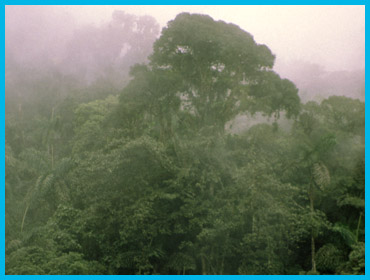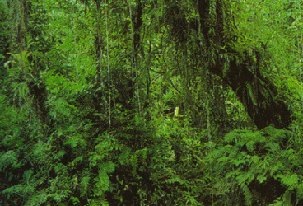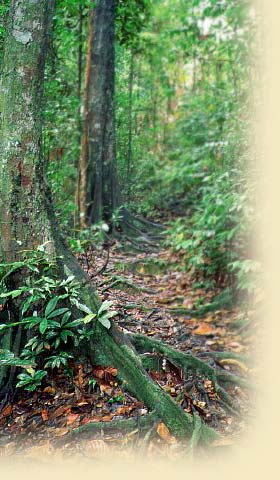
What and where are tropical rainforests

 Tropical rainforests (ˇ§Rain forestˇ¨-two words-is the older usage, most modern authors and researchers combine the two into
ˇ§Rainforestˇ¨.) are forested areas which lie between the Tropic of Cancer and the Tropic of Capricorn; receive rainfall regularly
throughout the year (80- 400 inches or 4 to 8 meters a year); and remain warm and frost free all year long with no seasonality (mean temperatures are
between 70˘X and 85˘XF) with very little daily fluctuation. Tropical rainforests are the Earth's oldest living ecosystems. Fossil
records show that the forests of Southeast Asia have existed in more or less their present form for 70 to 100 million years. They comprise only 40%
of the world's tropical forests and only 20% of the world's total forests. They cover 6-7% of the Earth's land surface, yet they house over half the
plant and animal species on Earth. They originally covered at least twice that area.
Tropical rainforests (ˇ§Rain forestˇ¨-two words-is the older usage, most modern authors and researchers combine the two into
ˇ§Rainforestˇ¨.) are forested areas which lie between the Tropic of Cancer and the Tropic of Capricorn; receive rainfall regularly
throughout the year (80- 400 inches or 4 to 8 meters a year); and remain warm and frost free all year long with no seasonality (mean temperatures are
between 70˘X and 85˘XF) with very little daily fluctuation. Tropical rainforests are the Earth's oldest living ecosystems. Fossil
records show that the forests of Southeast Asia have existed in more or less their present form for 70 to 100 million years. They comprise only 40%
of the world's tropical forests and only 20% of the world's total forests. They cover 6-7% of the Earth's land surface, yet they house over half the
plant and animal species on Earth. They originally covered at least twice that area.
 The earliest written description of rainforests in Western literature seems to be that of Christopher Columbus, but the term tropical rain forest was
coined in 1898 by the famous German plant geographer, Alfred Schimper, who first called it Tropische
Regenwald. The tropical rain forest is characterized by evergreen woody vegetation with a high and usually closed upper canopy 30 to 50 m
(100-165 ft) above ground level. Numerous seedlings and herbaceous plants dominate the ground layer and there is often a rich epiphyte community,
such as orchids and bromeliads, that grows on the trunks and branches. Tropical rain forests are usually stratified in the sense of having
three to five layers. An understorey, a closed canopy, and emergents are almost always recognizable.
The earliest written description of rainforests in Western literature seems to be that of Christopher Columbus, but the term tropical rain forest was
coined in 1898 by the famous German plant geographer, Alfred Schimper, who first called it Tropische
Regenwald. The tropical rain forest is characterized by evergreen woody vegetation with a high and usually closed upper canopy 30 to 50 m
(100-165 ft) above ground level. Numerous seedlings and herbaceous plants dominate the ground layer and there is often a rich epiphyte community,
such as orchids and bromeliads, that grows on the trunks and branches. Tropical rain forests are usually stratified in the sense of having
three to five layers. An understorey, a closed canopy, and emergents are almost always recognizable.
(Right) Bornean dipterocarp forests can reach heights of over 200 feet. Beneath their lofty branches, one finds a burgeoning world of living things.
The word "jungle" is derived from the Hindi jangal, meaning a wild, rough or waterless place, but the English term has come more to mean thick, impenetrable rain forest vegetation. Even in this sense most rain forest is not jungle, though the popular image is still widespread. Most of the world's rain forests are within 10˘Xof the equator. Tropical rain forests contain most of our planet's biodiversity and there are probably still millions of insects that have not been scientifically recorded. Rain forest has also been used to describe some temperate communities, where rainfall and humidity are high and winters mild. These temperate latitude forests, however, are dominated by one or two species of large tree and are thus quite different from the highly diverse tropical rain forests.
On the outside, a rain forest has a wall averaging 20 feet thick that is made of a tangle of vines that love light. This wall seals off the interior creating the illusion that the whole jungle is this thick.
 Tropical rainforests are located around the equator from the Tropic of
Cancer in the north, to the Tropic of Capricorn in the south at elevations below 3,000 feet.
This 3,000 mile (4800 km) wide band is called the "tropics". The largest rainforests are in Brazil (South America), Zaire (Africa) and Indonesia (South East
Asia). Other tropical rainforests lie in Southeast Asia, Hawaii and the Caribbean Islands. The Amazon rainforest in South America is the world's largest, covering an
area about two-thirds the size of the continental United States.
Tropical rainforests are located around the equator from the Tropic of
Cancer in the north, to the Tropic of Capricorn in the south at elevations below 3,000 feet.
This 3,000 mile (4800 km) wide band is called the "tropics". The largest rainforests are in Brazil (South America), Zaire (Africa) and Indonesia (South East
Asia). Other tropical rainforests lie in Southeast Asia, Hawaii and the Caribbean Islands. The Amazon rainforest in South America is the world's largest, covering an
area about two-thirds the size of the continental United States.